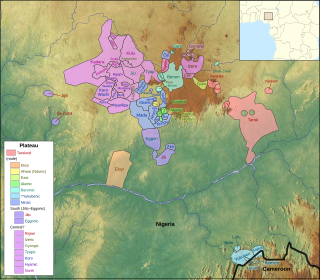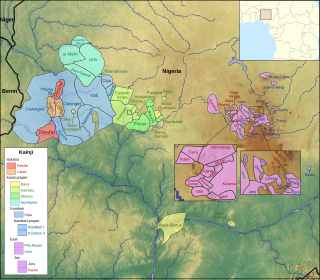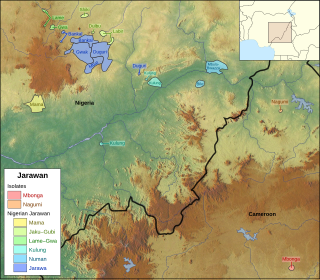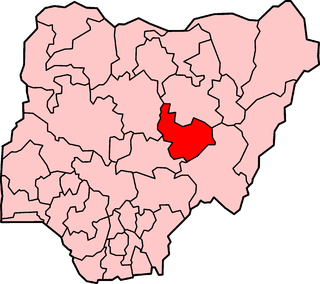| Language | Branch | Cluster | Dialects | Alternate spellings | Own name for language | Endonym(s) | Other names (location-based) | Other names for language | Exonym(s) | Speakers | Location(s) | Notes |
|---|
| Map | Amic | | | Amon, Among | Timap | Kumap pl. Amap | | Ba | | 3,550 (NAT 1950) | Plateau State, Bassa LGA; Kaduna State, Saminaka LGA | |
| Atsam | A | | | | | sg. Tsam, pl. Atsam | | | Chawai, Chawe, Chawi | 10,200 (1931 Gunn); 30,000 (1972 Barrett) | Kaduna State, Kachia LGA | |
| Bishi | A | | Riban (Ngmgbang) was formerly listed as a dialect, but is clearly a distinct language | Abisi, Bisi | | xx pl. Abishi | | Pitti | | 1,600 (NAT 1950); Live in at least 26 villages (Ajaegbu et al. 2013) | Kaduna State, Saminaka LGA | no data |
| Ngmgbang | A | | Formerly listed as a dialect of Bishi, but is clearly a distinct language | Ribam | Rigmgbang | | | | | few villages (Ajaegbu et al. 2013) | Kaduna State, Saminaka LGA | no data |
| Lere cluster (extinct) | "Northern Jos" | Lere (extinct) | | | | | | | | 765 (NAT 1949); 1,000 (1973 SIL); languages extinct | Bauchi State, Toro LGA | |
| Si | "Northern Jos" | Lere (extinct) | | | | Rishuwa | Kauru | Kuzamani | | | | |
| Gana (extinct) | "Northern Jos" | Lere (extinct) | | | | | | | | Extinct | | |
| Takaya (extinct) | "Northern Jos" | Lere (extinct) | | | | | | Taura | | Extinct | | |
| Gamo–Ningi cluster | Gamo-Ningi | Gamo–Ningi | | | | | | | | 15,000 but most speak Hausa. | Bauchi State, Ningi LGA | |
| Gamo | Gamo-Ningi | Gamo–Ningi | | | tì-Gamo | dòò-Gamo pl. à-ndi-Gamo | | Butancii | Buta, Butawa, Butu | There are some 32 settlements of Gamo, but of these only Kurmi still spoke the language in 1974 (Shimizu 1982). | | |
| Ningi | Gamo-Ningi | Gamo–Ningi | | | | | | | | | | |
| Iguta | C | | | | | Anaguta | Naraguta | | | 2,580 (HDG); 3,000 (1973 SIL) | Plateau State, Bassa LGA | |
| Janji | C | | | Jenji | Tìjánjí | Ajanji | | | Anafejanzi | 360 (NAT 1950) | Plateau State, Bassa LGA | |
| Jere cluster | C | Jere | | Jera, Jeere | | | | | | 23,000 (1972 SIL) | Plateau State, Bassa LGA; Bauchi State, Toro LGA | |
| Boze | C | Jere | Boze is divided into 3 dialects, εGorong, εKɔkɔŋ as well as a third rather divergent speech form, εFiru | Anabeze | eBoze | unaBoze pl. anaBoze | Buji | | | εGorong (2500?), εKɔkɔŋ (3000) εFiru (1500?) (Blench est, 2003). Due to language loss, especially in road settlements, there are considerably more ethnic Boze. Ethnologue figures are total district populations, not speakers. | Plateau State, Bassa LGA. Both sides of the Jos-Zaria road, directly north of Jos. | |
| Gusu | C | Jere | | Gussum | i–Sanga | sg. o–Sanga, pl. a–Sanga | | Anibau, Anosangobari | | 2,350 (1936 HDG) | Plateau State, Bassa LGA; Bauchi State, Toro LGA | |
| Jere | C | Jere | | | Ezelle | Anazele, Azelle | Jengre | | | 4,500 (1936 HDG) | Plateau State, Bassa LGA; Kaduna State, Saminaka LGA | |
| Ibunu-Lɔrɔ | C | Jere | | Bunu | Ìbunu; iLɔrɔ | Ànarubùnu, (Anorubuna, Narabuna); ɔnɔLɔrɔ pl. AnoLɔrɔ | Rebina, Ribina, Rubunu | | | 2,000 (LA 1971); 1500 (Blench 2003) in four villages | Bauchi State, Toro LGA | |
| Panawa | C | Jere | | | iPanawa | unuPanawa pl. anaPanawa | Bujiyel | | | 1600 CAPRO (1995a). 3500 (Blench 2003) in five villages | Bauchi State, Toro LGA | |
| Tunzu | C | | | | one person Tunzú, people àTunzû | ìTunzû | Dugusa, Duguza | | | 2500 speakers (Blench 2003 est.), though there are likely 2000 more ethnic Tunzu who do not speak the language. | Plateau State, Jos East Local Government (5 villages), main settlement at N10˚ 02, E 9˚ 06. Bauchi State, Toro LGA (2 villages) | |
| Sheni-Ziriya-Kere cluster | C | Sheni-Ziriya-Kere | | | | | | | | | | |
| Sheni | C | Sheni-Ziriya-Kere | | Shani, Shaini | tiSeni | one person onoSeni, people anaSeni | | | | 6 fluent speakers remaining out of ethnic community of about 1500 (Blench 2003) | Kaduna State, Lere LGA. Two settlements, Sheni (N10˚ 22.6, E 8˚ 45.9) and Gurjiya (N10˚ 21.5, E 8˚ 45.2) | |
| Kere (extinct) | C | Sheni-Ziriya-Kere | | | | | | | | extinct (Blench 2003) | Kaduna State, Lere LGA. Kere | |
| Ziriya (extinct) | C | Sheni-Ziriya-Kere | | Jiriya | | | | | | extinct (ethnic community ca. 2000) | Bauchi State: Toro LGA: Ziriya (N10˚ 22.6, E 8˚ 50) | |
| Nu | Kauru | | | | Tinu | Binu pl. Anu | Kinugu, Kinuka, Kinuku | | | 460 (NAT 1949); 500 (1973 SIL); 3000 (est. 2016). About seven villages | Kaduna State, Saminaka LGA | |
| Tumi | Kauru | | | | Tutumi | | Kitimi | | | 635 (NAT 1949) | Kaduna State, Saminaka LGA | no data |
| Bin | Kauru | | | Bina | tìBin | bìBin pl. áBin | | Bogana | Binawa | 220 (NAT 1949), 2,000 (1973 SIL). 4 villages (2016) ca. 3-4000 (est.) | Kaduna State, Saminaka LGA. About 15 km west of Mariri, along the Geshere road. | |
| Gbiri–Niragu cluster | Kauru | Gbiri–Niragu | | | | | | | | 5,000 (1952 W&B) | Kaduna State, Saminaka LGA | |
| Gbiri | Kauru | Gbiri–Niragu | | | Igbiri, Agari, Agbiri | | Gura, Gure, Guri | | | | | |
| Niragu | Kauru | Gbiri–Niragu | | | Anirago, Aniragu | | Kafugu, Kagu, Kahugu, Kapugu | | | | | |
| Kurama | Kauru | | | | Tikurumi | Akurumi | | Bagwama (also refers to Ruma) | | 11,300 (NAT 1949) | Kaduna State, Saminaka and Ikara LGAs; Kano State, Tudun Wada LGA | |
| Ruma | Kauru | | | Rurama | Turuma | Arumaruma | | Bagwama (also refers to Kurama) | | 2,200 (NAT 1948) | Kaduna State, Saminaka LGA | |
| Shuwa–Zamani | Kauru | | | | | | | | | | Kaduna State, Saminaka LGA | |
| Vori | Kauru | | | | TiVori | PiVori pl. AVori | Srubu, Skrubu, Surubu, Zurubu | Fiti | | 1,950 (NAT 1948) | Kaduna State, Saminaka LGA | |
| Dungu | Kauru | | | Dungi, Dingi, Dwingi, Dunjawa | | | | | | 310 (NAT 1949) | Kaduna State, Saminaka LGA | no data |
| Kono | Kauru | | | Konu, Kwono | | | | | | 1,550 (NAT 1949) | Kaduna State, Saminaka LGA | no data |
| Mala | Kauru | | | | Tumala | Amala | Rumaya, Rumaiya | | | 1,800 (NAT 1948) | Kaduna State, Saminaka LGA | no data |
| Vono | Kauru | | | | Kivɔnɔ | Avɔnɔ | | Kibolo, Kiwollo, Kiballo | | 335 (NAT 1949); 500 (1973 SIL) | Kaduna State, Saminaka LGA | no data |
| Kaivi | Kauru | | | Kaibi | | | | | | 650 (NAT 1949) | Kaduna State, Saminaka LGA | no data |
| Gyem | Lame | | | Gema | | | | | | 2000 (est. 2015) | Bauchi State, Toro LGA, Lame district | |
| Shau | Lame | | | Sho | Lìsháù | | | | | Almost extinct | Bauchi State, Toro LGA, villages of Shau and Mana | |
| Kudu–Camo cluster | Ningi | Kudu–Camo | Basa said to be a sub–group | | | | | | | Language moribund, perhaps extinct | Bauchi State, Ningi LGA | |
| Kudu | Ningi | Kudu–Camo | | Kuda | | | | | | Probably extinct | | |
| Camo | Ningi | Kudu–Camo | | Chamo | | | | | | Probably extinct | | |
| Lemoro | North-Central | | | Limorro | Emoro | Anemoro | Anowuru | | | 2,950 (1936 HDG) | Plateau State, Bassa LGA; Bauchi State, Toro LGA | |
| Sanga | North-Central | | | | Aŋma Asanga | Asanga | | | | 1,700 (NAT 1950); 5,000 (1973 SIL) | Bauchi State, Toro LGA, Lame district | |
| Zora | North-Central | | | | iZora | uZora pl. aZora | | | Cikobu, Chokobo | 425 (1936 HDG), 19 speakers (March 2016); 10 settlements close to N10˚ 21.7, E 8˚ 50.6. About 3-4000 ethnic Zora. | Plateau State, Bassa LGA | |






